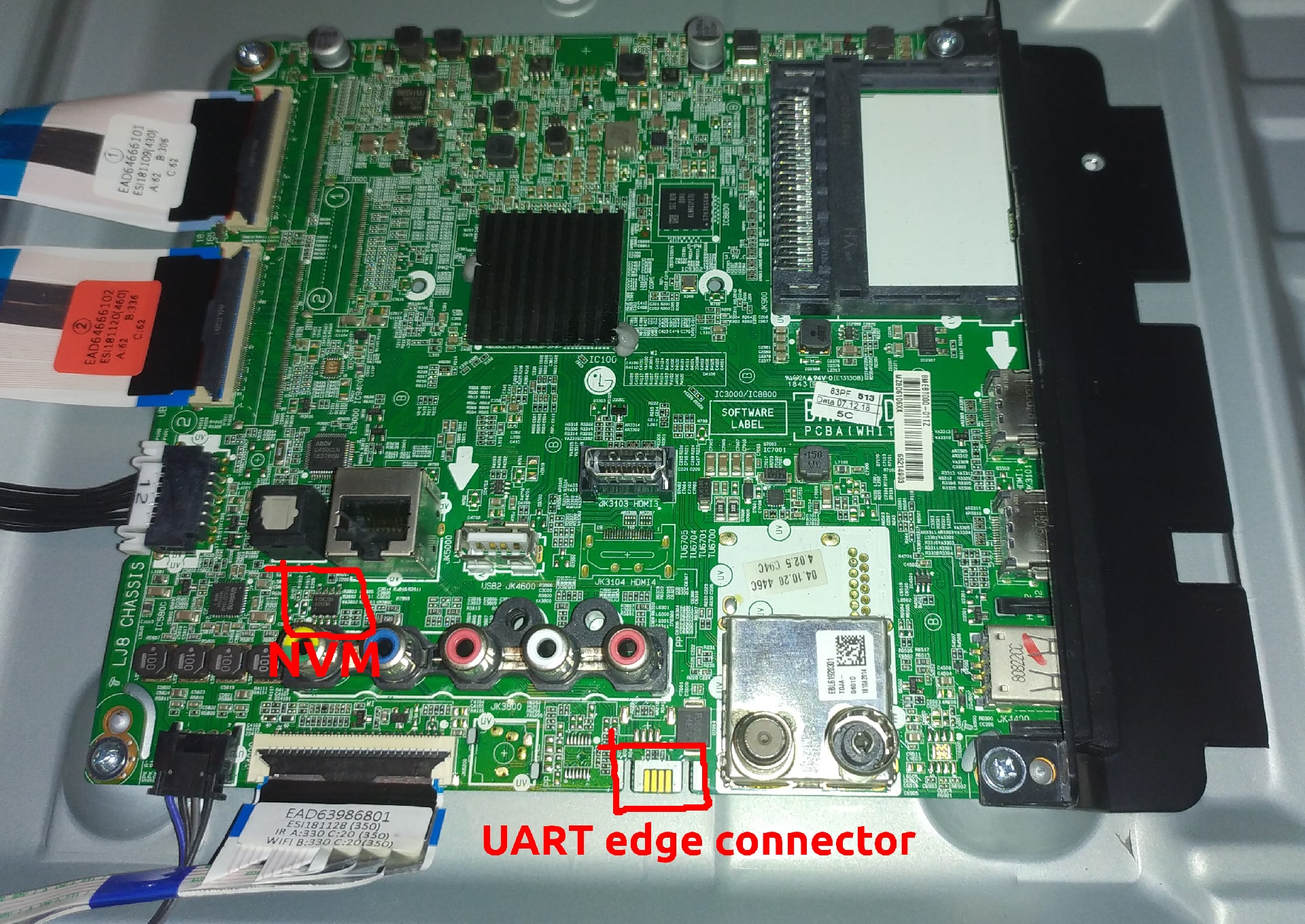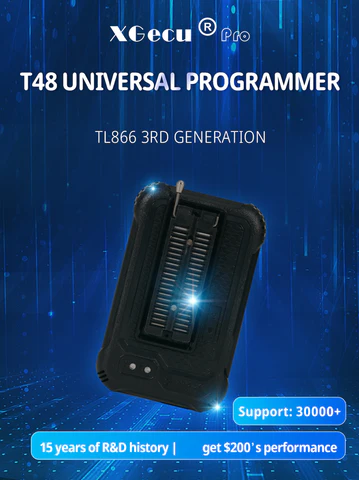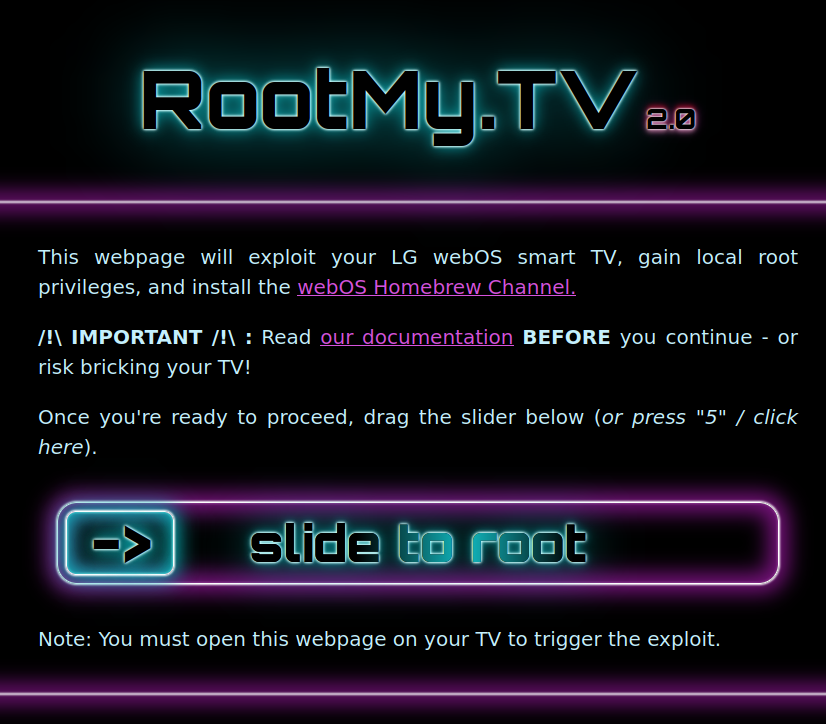Hacking my LG webOS TV (again)
Created: 2023-05-27
- Introduction
- Modifying debugstatus in NVM
- The Goal
- Dump contents of NVM EEPROM
- Total failure?
- Verify GPL structure / Digging into the source
- RootMyTV v2
- Blocking LG SW OTA domains
- Final words
Introduction
I have an LG smart TV at home which I bought around 2018 that has survived 3-4 apartment moves ( which in itself feels like an achievement). Though it still receives webOS updates fairly often, there is some support from third-party apps that have started to drop. For example, HBO Max stopped supporting my TV around 2021 which I thought was ridiculous, you expect a popular third-party app to be supported for longer than 3 years from when you bought your fancy new TV .. right? If HBO Max can drop support, what if other platforms like Netflix or Amazon also does it? Do I need to replace my dumb living room monitor with another device or do I extend its life with a chrome cast?
Anyways, I instead started to look into how to cram out even more capabilities from my TV. This led me to RootMyTV (V1), a straightforward way of rooting webOS LG TVs without having to use any external device at all. Root access together with , an unofficial webOS application store, unlocked more potential from my TV. I also started looking into making webosbrew apps myself but never really finished anything that I want to make public yet. Since then I have been on/off active in the openlgtv community.
Recently I looked into gaining root access again. I say again because my girlfriend accidentally updated the TV to a newer webOS version that patched the previous vulnerability that I used to gain root access. (I consider it my fault since I should have been more cautious and blockd all LG software download OTA domains).
Here I am, back at it again!
TV info dump:
| Type | Description |
|---|---|
| Model | 55UK6300PLB |
| webOS Version | 4.4.0-12 (goldilocks-gorce) |
| Chip type | LM18A (Mstar) |
| S/W version | 05.40.26.01 |
| NVM EEPROM IC | FT24C256A |
Modifying debugstatus in NVM
Before you read this do know that I took a huge detour on this root adventure when looking into how to write to NVM. The NVM is what LG calls the EEPROM that stores configuration data used for developer settings e.g. toggle logging, toggle UART serial, baud rates etc. Debugstatus is the " flag" that determines whether to enable debug mode for a developer or perpetrator (me) to access these settings. This page explains more in-depth on what NVM is and how to read and write to on older LG models . I put some hours into researching how to do it, what software and tools I need and even went as far as looking at the LG source code.
...Ultimately, the RootMyTV-way worked without me even noticing it so even though this section might be interesting for people like me who get excited over embedded stuff, there isn't a payoff here. Skip to here if you want to see the results of what gave me root access and what I did after gaining root access.
The Goal
Short overview of what I want to achieve:
- Dump contents of NVM EEPROM
- Verify that it matches the structure GPL structure i.e. find what address debugstatus is written to
- Write to EEPROM override debugstatus RELEASE --> DEBUG
- Enable UART in developer settings
- Connect serial monitor to UART edge connector, verify that I have a root shell
- Activate persistant root mode
- Install homebrew channel and verify persistant root status

Dump contents of NVM EEPROM
To modify NVM I need a device capable of writing to an EEPROM. I recently bought a universal programmer tool that luckily supports read/write to the FT24C256A, which is my device's EEPROM.

Look at all the lens flare such an amazing universal programmer!
The T48 universal programmer 3G is not yet supported by minipro, an open-source program for controlling the MiniPRO TL866xx series of chip programmers which has a great CLI interface that I originally wanted to use (there is an open issue on supporting the T48 here). Instead, I have to rely on the program that came with it, xgrpo.
Running xgpro.exe on wine Ubuntu
- Installation instructions for ubuntu: https://wiki.winehq.org/Ubuntu, at the time of writing I had to run these commands:
# Yes we need 32 bit architecture to run xgpro...
sudo dpkg --add-architecture i386
# Download and add the repository key
sudo mkdir -pm755 /etc/apt/keyrings
sudo wget -O /etc/apt/keyrings/winehq-archive.key https://dl.winehq.org/wine-builds/winehq.key
# Check Ubuntu version
lsb_release -sr
# I have 22.04 so I download that source
sudo wget -NP /etc/apt/sources.list.d/ https://dl.winehq.org/wine-builds/ubuntu/dists/jammy/winehq-jammy.sources
sudo apt update
sudo apt install --install-recommends winehq-stable
sudo apt install --install-recommends winehq-devel
- Add an alias for running wine in either 32bit architecture (default 64bit)
alias wine32="WINEARCH=win32 WINEPREFIX='/home/$USER/.wine32' wine"
- XGecu Xgpro software is annoying to download from the Chinese supplier's webpage. But I found and used [Kreeblah's github mirror where many release versions (if not all) are uploaded.
- Install Xgpro in Wine:
wine32 ~/Downloads/xgproV1255_setup/XgproV1255_Setup.exe
- Run installed binary:
wine32 /home/$USER/.wine/drive_c/xgpro/Xgpro.exe
- My suggestion is that you add an alias for running this binary:
alias xgpro="wine32 ~/.wine/drive_c/xgpro/Xgpro.exe"
Now you should be able to write and read to ICs that are supported by your EEPROM programmer.
Total failure?
My first few attempts to read did not go very well. I couldn't get my SOIC8 clip adapter for my T48 to get a good connection to the EEPROM and every read got me different results. I want to be sure that my reading is stable enough to produce the same results every time before I even attempt to write. The ethernet port was conveniently placed directly next to the EEPROM so that my SOIC8 clip was perfectly out of reach. If I want a good connection I would either need to get a smaller SOIC clip or solder on wires directly to the chip.
Verify GPL structure / Digging into the source
Before adding more risk of bricking my device I want to verify that it is even possible with my firmware version + chip type combination. I decided to first consult the source code before attempting any soldering or buying additional clips.
LG source code is available on https://opensource.lge.com/ for download. Code snippets that I downloaded from there are slightly modified below to be more easily read e.g. fixing their mixing of spaces and tabs.
In gpl_lm18a_MR_boot/boot/MstarCustomer/cmd/cmd_lg/cmd_nvm.c we can see the system database (The funny characters from the source code are not me). I have marked the line where we see debugstatus is initialised to release level.
const SYS_DB_T gSysNvmDB =
{
0x20170707,
DEFAULT_PRINT_MASK,
0, /* PDP panel use time */
0, /* FRC auto download or not */
{50, 570, 33, 50, 50, 50}, /* panel powerseq */
{ 0, 0, 80, 5, 99, 99, 5, 35, 96, 120, 100, 22, 200, 0x0C }, /* panel pwm */
#if 0 //(SYS_ATSC)
0, /*system type 0:atsc, 1: dvb*/
#else
1, /*system type 0:atsc, 1: dvb*/
#endif
1, /**COLOR_DEPTH_T */
1, /**LVDS_PIXEL_T */
0, /*Vcom Pgamma value checksum */
0xFF,
0xFF, /* SoftwareUpdate Mode */
0xFF, /* Make Hibernation Mode */
0xFF, /* Snap Shot Support or not */
1, /* ADC Mode [L9] Internal */
0xFFFFFFFF, /* SWU Mode Magic Key */
0, /* sound out mode */
0xFFFFFFFF, /* zram */
0, /* eMMCUsage */
0, /* bDPortEnable */
0xff, /* Secureboot full verify flag */
0, /* PWM Mode */
0, /* timeDifference */
0, /* LKCDEnable */
0x43, /* criu support or not */
{0, 0, 0, 0, 0, RELEASE_LEVEL, 0, 0, 0, 0, 0, 0, 0, 0, 0, 0, 0, 0, 0, 0, 0, 0, 0, 0, 0, 0, 0, 0, 0, 0, 0, 0},
0xFF, /* Instant boot support or not */
0, /* Snapshot boot ART support or not */
};
...and in gpl_lm18a_MR_boot/boot/MstarCustomer/include/lg_modeldef.h the three different levels of debugstatus are defined
#define DEBUG_LEVEL 3
#define EVENT_LEVEL 4
#define RELEASE_LEVEL 5
The struct declaration for SYS_DB_T is located in gpl_lm18a_MR_boot/boot/MstarCustomer/include/cmnio_type.h.
/**
* System DB ¸ðµâÀ» À§ÇÑ ½ÇÁ¦ »ç¿ë type Á¤ÀÇ
* (from os/common_linux/dil/include/dil_nvm.h)
*/
typedef struct
{
UINT32 validMark;
OSA_PRINT_MASK_T printMask;
UINT32 sys_utt; /* PDP panel use time */
UINT8 frcDownloadMode; /* FRC auto download or not */
PANEL_POWER_SEQ_T panelpowerseq; /* For panel power sequence timing */
PANEL_PWM_T panelpwm; /* For panel pwm */
UINT8 systemtype; /*system type 0:atsc, 1: dvb*/
UINT8 ColorDepth; /**COLOR_DEPTH_T */
UINT8 LVDSPixel; /**LVDS_PIXEL_T */
UINT8 vcomPgammaChecksum; /*Vcom Pgamma value checksum */
UINT8 nDebugStatus; /* to apply encypted debugStatus feature (nEncyptedDebugStatus[32]), this param will be used no more. but it will be leaved for compatibility */
UINT8 swuMode; /* swu mode */
UINT8 make_hib; /* for snapshot boot (make building) */
UINT8 snapshot_onoff; /* for snapshot support or not*/
UINT32 adcMode; /* for adc Mode ÇöÀç ADC ¼³Á¤ °ªÀ» ÀúÀå */
UINT32 swum_magic; /* swu mode magic */
UINT8 soundout_mode; /* soundout mode save 0:tv speaker, 1:external speaker 2:optical sound bar, 3:headphone,4:lineout,5;bluetooth soundbar */
UINT32 zram; /* zram */
UINT8 eMMCUsage; /* for eMMC Usage */
UINT8 bDPortEnable;
UINT8 fullVerify; /* Secureboot full verify flag */
UINT8 pwm_mode; /* PWM mode */
int timeDifference;
UINT8 bLKCDEnable; /* LKCD enable */
UINT8 bCRIUEnable; /* for criu support or not*/
UINT8 nEncryptedDebugStatus[32]; /* do not refer to this param by "typeof". this should be use internally in dil layer only */
UINT8 instant_onoff; /* for instant boot */
UINT8 snapshot_art; /* for snapshot boot art*/
} SYS_DB_T;
The reason why nEncryptedDebugStatus is 32 bytes of zero paddings among 1 byte debugstatus is that it is encrypted/decrypted before write/read. The encryption is AES-128 which I think uses a factory flashed device key stored in eMMC conveniently out of reach for me. This is part of the Mstar secure boot: gpl_lm18a_MR_boot/boot/MstarApp/src/secure/MsSecureBoot.c which I will not go into detail.
RootMyTV v2
By using RootMyTV (sliding the slider) I got root access and homebrew channel installed. I could verify root status "ok" in homebrew channel. The next step is to make sure I have remote access as well.

To use my SSH pubkey authentication when connecting to the TV I had to enable telnet and manually add my key first.
# After rebooting the TV I could run these commands
$ telnet webostv
$ mkdir -p /home/root/.ssh
$ chmod 700 /home/root/.ssh
$ echo '<ssh pubkey from ~/.ssh/id_rsa.pub>' > /home/root/.ssh/authorized_keys
$ chmod 600 /home/root/.ssh/authorized_keys
# Disable telnet and reboot TV again
$ ssh webostv
NEVER EVER OVERWRITE SYSTEM PARTITIONS LIKE KERNEL, ROOTFS, TVSERVICE.
Your TV will be bricked, guaranteed! See https://rootmy.tv/warning for more info.
root@webostv:~#
My SSH config file (~/.ssh/config) contains this configuration:
host webostv
HostName webostv
User root
Where webostv hostname is configured in my router
Blocking LG SW OTA domains
I have root again, great! Time to be more cautious this time and block all those ~~pesky~~ LG domains that could remove my root access - again. After rooting I blocked domains on my OpenWRT router to prevent webos updates. I compiled the list of domains from openlgtv discord to be used by simple-adblock running on OpenWRT. The domain list can be found here and can be configured in simple-adblock in /etc/config/simple-adblock:
config simple-adblock 'config'
option config_update_enabled '0'
option config_update_url 'https://cdn.jsdelivr.net/gh/openwrt/packages/net/simple-adblock/files/simple-adblock.conf.update'
option dns 'dnsmasq.servers'
option dns_instance '0'
option verbosity '2'
option force_dns '1'
option led 'none'
option boot_delay '120'
option download_timeout '10'
option curl_retry '3'
option parallel_downloads '1'
option debug '0'
option compressed_cache '0'
list blocked_hosts_url 'https://gist.githubusercontent.com/kjeller/5c1f6aea1c5e6d5a70091a78b0eda6f2/raw/bda9a569c37bb794225f5af41c4f7c65ac598dab/hosts.txt'
option enabled '1'
Final words
Huge thanks to the people over at openlgtv for providing all the necessary information. Even though I failed with the "write to NVM strategy" I feel like I got some more insight into how my system works. I would like to explore more devices using hands-on techniques like this and this was a nice introduction to that. It is also a reminder to revisit options that were previously known to fail. I feel like I tried RootMyTv v2 multiple times unsuccessfully before I decided to crack open my TV. But lookie lookie it was an oversight from me.
